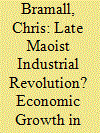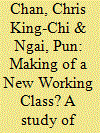| Srl | Item |
| 1 |
ID:
169796


|
|
|
|
|
| Summary/Abstract |
According to the conventional wisdom, the promise of the Chinese revolution of 1949 went unfulfilled in the Maoist era. Instead of taking off, the economy grew slowly, and widespread rural poverty persisted. The economic turning point was instead the famous political climacteric of 1976–78. But this metric of aggregates is the wrong criterion by which to judge China's economic record because industrial revolutions have regional beginnings. They invariably take place against a backcloth of slow aggregate growth and stagnant material living standards. Accordingly, we should dwell neither on China's slow overall growth nor its widespread poverty before 1978 but look instead for evidence of an emerging regional growth pole. This article argues that Jiangsu was such a growth pole in the late Maoist era, and that its record bears comparison with that of Lancashire and Yorkshire during the early years of Britain's industrial revolution. This holds out the intriguing possibility that a Chinese economic take-off, diffusing out of the Yangtze Delta, would have occurred even without post-1978 policy changes.
|
|
|
|
|
|
|
|
|
|
|
|
|
|
|
|
| 2 |
ID:
089755


|
|
|
|
|
| Publication |
2009.
|
| Summary/Abstract |
In this study, we argue that the specific process of the proletarianization of Chinese migrant workers contributes to the recent rise of labour protests. Most of the collective actions involve workers' conflict with management at the point of production, while simultaneously entailing labour organizing in dormitories and communities. The type of living space, including workers' dormitories and migrant communities, facilitates collective actions organized not only on bases of locality, ethnicity, gender and peer alliance in a single workplace, but also on attempts to nurture workers' solidarity in a broader sense of a labour oppositional force moving beyond exclusive networks and ties, sometimes even involving cross-factory strike tactics. These collective actions are mostly interest-based, accompanied by a strong anti-foreign capital sentiment and a discourse of workers' rights. By providing detailed cases of workers' strikes in 2004 and 2007, we suggest that the making of a new working class is increasingly conscious of and participating in interest-based or class-oriented labour protests.
|
|
|
|
|
|
|
|
|
|
|
|
|
|
|
|